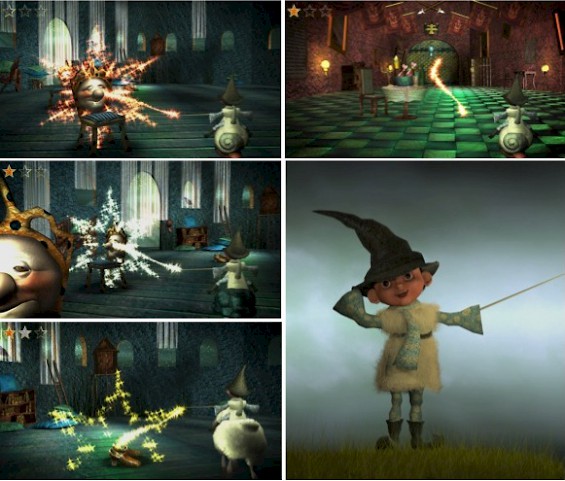"Magic Castle"

The Lokomat-based RehabGame “Magic Castle” uses a third-person view and follows the interpretation of biofeedback values described above. The game is controlled by Lokomat® and a “Color Tracking” device for upper extremities, which are linked to the game through “RehabConnex”. The patient is given a “magic wand”, which is tracked by the “Color Tracking” system, locating its position. The game controls can be mirrored and set for right- or left-handed use. Optionally, “Magic Castle” can also be played without the “Color Tracking” system, using only the Lokomat® input.
The game features “Lino”, a little wizzard, riding on a giant snail, a tortoise or a sheep through an enchanted castle, filled with sleeping fairy tale characters (score-items). “Lino’s” task is to wake up the characters with his magic wand. Depending on the biofeedback level, the wizard will ride on a giant snail with a bronze magic wand, on a tortoise with a silver wand or on a sheep with a golden wand. The speed of these animals will remain constant; their general velocity can be manually adjusted by the therapist, but will not distinguish between the kind of animals. “Lino’s” path through the castle is predetermined, leading from one enchanted fairy tale character to another. To score points, “Lino” wakes up “friendly” characters and earns a bronze, a silver or a golden star (depending on the current biofeedback level). If he wakes up the “evil” character (a spider), he will again lose one star. If “Lino” reaches the exit of a chamber with enchanted characters still left over in the room, the giant door’s lock will blow him back to the beginning of the room and the ride will be repeated. The maximum number of points depend both on the amount of score-items available in a specific room and on the kind of riding animals (i.e. the levels of biofeedback). The little wizzard can be blown back maximum three times before he is allowed to leave the room and to enter a new one. There are 22 rooms and chambers, which can be manually choosen by the therapist at the beginning of the therapy session. Between leaving and entering the rooms, the patient gets a direct feedback of his/her performance by “Lino” himself who presents the current score.
Reference
A.L. Martin, U. Götz and R. Bauer, “Development of Task-specific RehabGame Settings for Robot-assisted Pediatric Movement Therapies,” In Proceedings of the 7th IEEE Consumer Electronics Society Games Media Entertainment Conference (GEM), IEEE Xplore Digital Library, 2014, pp. 1-4.
A.L. Martin, U. Götz and R. Bauer, “IMIC – Innovative Movement Therapies in Childhood”, Neurol Rehabil, C., Dettmers, P.W. Schönle, C. Weiller, Eds., 20th ed., vol. 4, Hippocampus: Bad Honnef, 2014, pp. 215-225.
